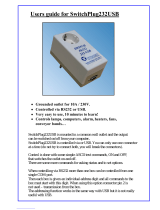
TMCM-1180 and PD86-1180 TMCL Firmware V4.45 Manual (Rev. 1.10 / 2014-MAY-16) 2
Table of Contents
1 Features ........................................................................................................................................................................... 4
2 Overview ......................................................................................................................................................................... 5
3 Putting the PD86-1180 into Operation ................................................................................................................... 6
3.1 Starting up ............................................................................................................................................................. 6
3.2 Testing with a Simple TMCL Program ........................................................................................................... 9
3.3 Operating the Module in Direct Mode ......................................................................................................... 10
4 TMCL and TMCL-IDE ................................................................................................................................................... 11
4.1 Binary Command Format ................................................................................................................................ 11
4.2 Reply Format ....................................................................................................................................................... 12
4.2.1 Status Codes ................................................................................................................................................. 13
4.3 Standalone Applications .................................................................................................................................. 13
4.4 TMCL Command Overview .............................................................................................................................. 14
4.4.1 TMCL Commands ......................................................................................................................................... 14
4.4.2 Commands Listed According to Subject Area .................................................................................... 15
4.5 The ASCII Interface ........................................................................................................................................... 19
4.5.1 Format of the Command Line ................................................................................................................. 19
4.5.2 Format of a Reply........................................................................................................................................ 19
4.5.3 Configuring the ASCII Interface .............................................................................................................. 20
4.6 Commands ........................................................................................................................................................... 21
4.6.1 ROR (rotate right) ........................................................................................................................................ 21
4.6.2 ROL (rotate left) ............................................................................................................................................ 22
4.6.3 MST (motor stop) ......................................................................................................................................... 23
4.6.4 MVP (move to position) ............................................................................................................................. 24
4.6.5 SAP (set axis parameter) ........................................................................................................................... 26
4.6.6 GAP (get axis parameter) .......................................................................................................................... 27
4.6.7 STAP (store axis parameter) ..................................................................................................................... 28
4.6.8 RSAP (restore axis parameter) ................................................................................................................. 29
4.6.9 SGP (set global parameter) ....................................................................................................................... 30
4.6.10 GGP (get global parameter) ...................................................................................................................... 31
4.6.11 STGP (store global parameter) ................................................................................................................ 32
4.6.12 RSGP (restore global parameter) ............................................................................................................ 33
4.6.13 RFS (reference search) ................................................................................................................................ 34
4.6.14 SIO (set input / output) ............................................................................................................................. 35
4.6.15 GIO (get input/output) ............................................................................................................................... 37
4.6.16 CALC (calculate) ............................................................................................................................................ 39
4.6.17 COMP (compare) ........................................................................................................................................... 40
4.6.18 JC (jump conditional) ................................................................................................................................. 41
4.6.19 JA (jump always) ......................................................................................................................................... 42
4.6.20 CSUB (call subroutine)................................................................................................................................ 43
4.6.21 RSUB (return from subroutine) ................................................................................................................ 44
4.6.22 WAIT (wait for an event to occur) ......................................................................................................... 45
4.6.23 STOP (stop TMCL program execution) ................................................................................................... 46
4.6.24 SCO (set coordinate) ................................................................................................................................... 47
4.6.25 GCO (get coordinate) .................................................................................................................................. 48
4.6.26 CCO (capture coordinate) .......................................................................................................................... 49
4.6.27 ACO (accu to coordinate; valid from TMCL version 4.18 on) .......................................................... 50
4.6.28 CALCX (calculate using the X register) .................................................................................................. 51
4.6.29 AAP (accumulator to axis parameter) .................................................................................................... 52
4.6.30 AGP (accumulator to global parameter) ............................................................................................... 53
4.6.31 CLE (clear error flags) ................................................................................................................................. 54
4.6.32 VECT (set interrupt vector) ........................................................................................................................ 55
4.6.33 EI (enable interrupt) ................................................................................................................................... 56
4.6.34 DI (disable interrupt) .................................................................................................................................. 57
4.6.35 RETI (return from interrupt) ..................................................................................................................... 58
4.6.36 Customer Specific TMCL Command Extension (UF0… UF7 / User Function) ............................... 58
4.6.37 Request Target Position Reached Event ............................................................................................... 59
www.trinamic.com





















